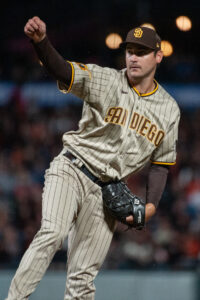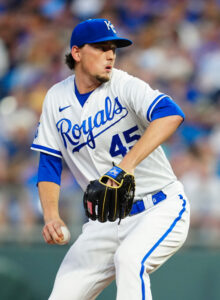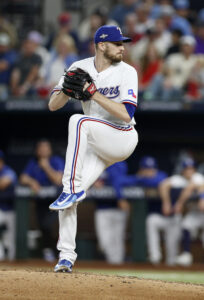December 18: The Royals have now officially announced the deal.
December 15: The Royals’ active offseason is continuing, as Kansas City has agreed to terms with free agent righty Michael Wacha, per a report from Robert Murray of FanSided. It’s a two-year, $32MM contract, ESPN’s Jeff Passan adds. The second season is a player option, so Wacha will have the opportunity to opt back into free agency next winter. The contract pays the CAA client an even $16MM in each season, per USA Today’s Bob Nightengale, and Anne Rogers of MLB.com tweets that Wacha can earn an additional $500K via incentives in each season of the deal.
It’s the second notable free-agent pickup of the day for the Royals, who also agreed to a two-year $13MM deal with Hunter Renfroe earlier this morning. Kansas City has also added righty Seth Lugo on a three-year, $45MM pact that contains an opt-out after the second season. Wacha and Lugo, who were teammates with the Padres in 2023, will join a Royals rotation that includes Cole Ragans, Brady Singer and Jordan Lyles. Depth options include Daniel Lynch, Kris Bubic (recovering from Tommy John surgery), Max Castillo, Alec Marsh and Jonathan Heasley, among others.
Wacha’s two-year, $32MM deal matches the exact terms of a two-year club option that the Padres declined earlier this offseason. The inclusion of an opt-out provision and some modest incentives makes this a stronger deal for the righty, however. Kansas City will be Wacha’s sixth team in six years, as his trips to free agency have routinely resulted in either a one-year pact (Mets, Rays, Red Sox) or a multi-year deal with options and/or opt-out opportunities (Padres).
Over the past two seasons, between the Red Sox and Padres, Wacha has posted a combined 3.27 ERA with a 21.3% strikeout rate, 6.9% walk rate and 37.7% ground-ball rate. Despite being more of a fly-ball pitcher, he’s allowed a manageable 1.14 homers per nine frames. Pitching his home games at the spacious Kauffman Stadium should help him continue to avoid the long ball at an acceptable rate despite his pronounced fly-ball tendencies.
In those two seasons, Wacha has changed up his pitch selection, reducing his reliance on a four-seamer while increasing the usage rates on his sinker and changeup. He threw both pitches at a career-high rate in 2022 and then set a new career-high in usage again in 2023. While the more frequent sinker usage hasn’t shown up in Wacha’s ground-ball rates, he’s posted improved batted-ball metrics; last year’s 88.1 mph average exit velocity and 35.4% hard-hit rate were both lower than the league averages of 89 mph and 39.2%, respectively. That’s helped Wacha to offset his slightly below-average strikeout rate.
The number of innings that the Royals can expect from Wacha is perhaps the biggest question mark surrounding him. Wacha has been placed on the injured list nine times in his big league career, with five of those IL placements stemming from shoulder troubles (including a six-week absence in the 2023 season). Wacha has also had IL stints for oblique, hamstring, knee and intercostal strains. While the shoulder is an obvious concern, Wacha did manage a solid 3.88 ERA in 48 2/3 innings after returning from this past season’s shoulder issue. He closed out the year with a pair of particularly impressive outings, tossing consecutive seven-inning gems (two total runs allowed on nine hits and two walks with 13 strikeouts).
With Wacha, Renfroe, Lugo, Will Smith, Chris Stratton and Garrett Hampson all signing major league deals in Kansas City this month, the Royals have committed $105MM in total free-agent dollars in a span of just over two weeks. It’s unlikely all of those dollars will end up being paid out, as each of Wacha, Renfroe, Stratton and Lugo received player options/opt-outs within their respective contracts. Still, it’s a hefty slate of investments by Kansas City’s standards — one that’s added an additional $47MM in payroll to the team’s 2024 roster (a net $45.75MM, when factoring in that Taylor Clarke and his $1.25MM salary were traded to the Brewers to make roster space for Lugo).
The relatively heavy investment in free-agent arms represents something of an acknowledgement from the Kansas City front office that its previous efforts to rebuild a homegrown rotation with a heavy focus on college arms in the draft simply hasn’t panned out. Singer, Lynch, Bubic, Marsh, Jackson Kowar and Asa Lacy were at one point focal components of the Royals’ hopes for the future, but only Singer remains locked into the rotation but is in need of a bounceback campaign after he was unable to carry his 2022 breakout into the 2023 season. Kowar was traded to the Braves for injured starter Kyle Wright (who’ll miss all of 2024). Lacy has yet to reach the Majors. Lynch and Marsh haven’t established themselves. Bubic showed some promise before tearing his left ulnar collateral ligament and undergoing Tommy John surgery.
Kansas City’s new-look rotation should represent a massive improvement over last year’s group, which pitched to a combined 5.12 ERA, ranking 27th in the big leagues. Gone from that mix are Brad Keller, Ryan Yarbrough and (at least for now) Zack Greinke. Other key names in 2023, Lynch most prominently, have been pushed down the depth chart. It’s not yet clear what lies ahead for the Royals and Greinke. The future Hall of Famer spent the past two seasons back with his original organization and at least ostensibly seemed poised to close out his career there. It’s possible the two parties still come to terms on another one-year pact, as Greinke is preparing to pitch in 2024, but that would likely push Lyles to the bullpen (or perhaps prompt the Royals to explore a potential trade of the veteran innings eater).

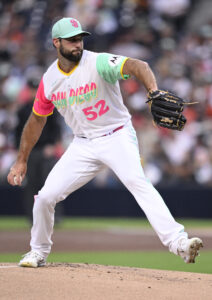
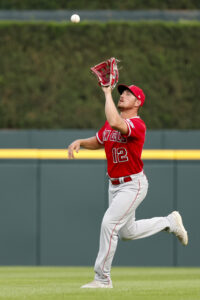 Renfroe, 32 in January, has been incredibly nomadic in recent seasons, which is likely a reflection of his enticing power but limited overall profile. He began his career with the Padres but has subsequently bounced to the Rays, Red Sox, Brewers, Angels and Reds, meaning he’s worn six jerseys in the past five years, with this deal set to make it seven in six.
Renfroe, 32 in January, has been incredibly nomadic in recent seasons, which is likely a reflection of his enticing power but limited overall profile. He began his career with the Padres but has subsequently bounced to the Rays, Red Sox, Brewers, Angels and Reds, meaning he’s worn six jerseys in the past five years, with this deal set to make it seven in six.